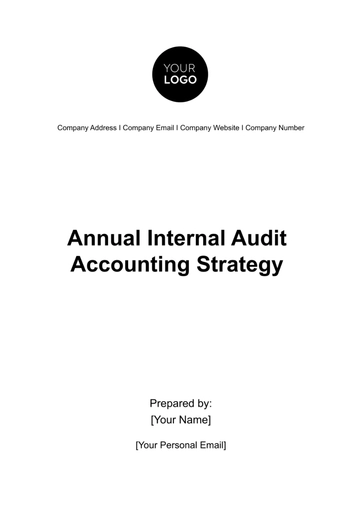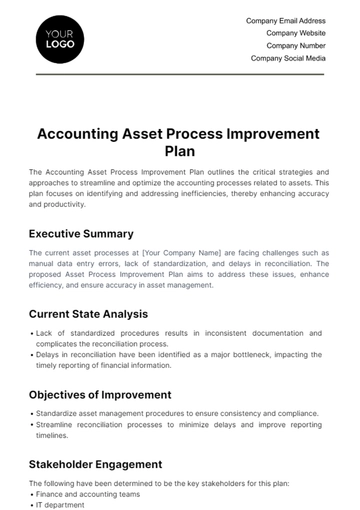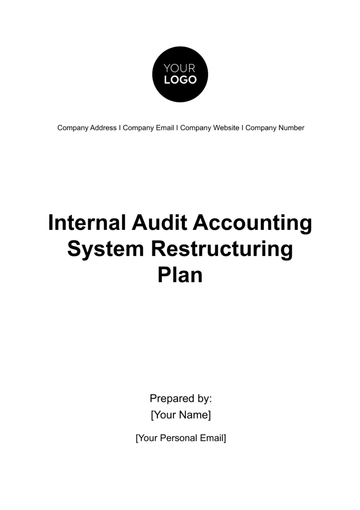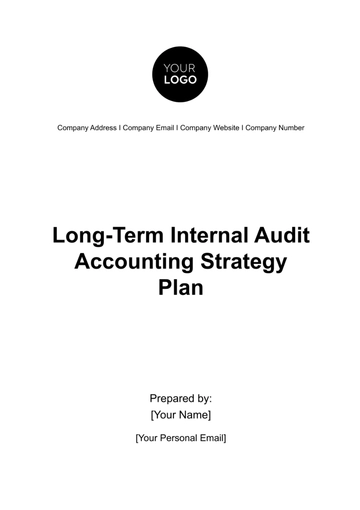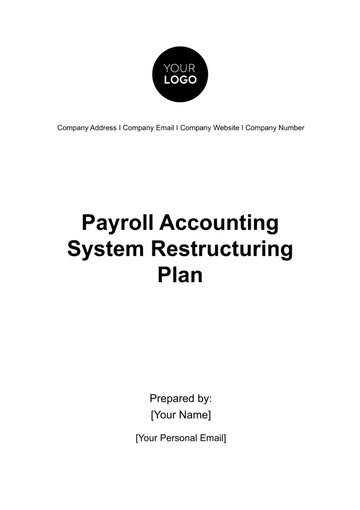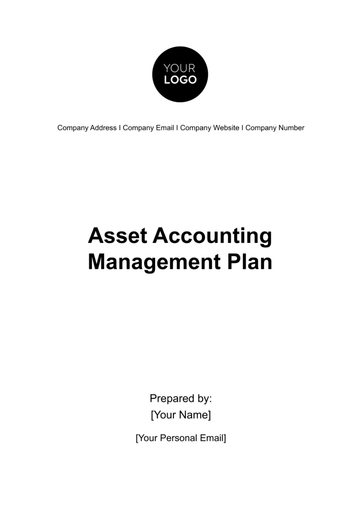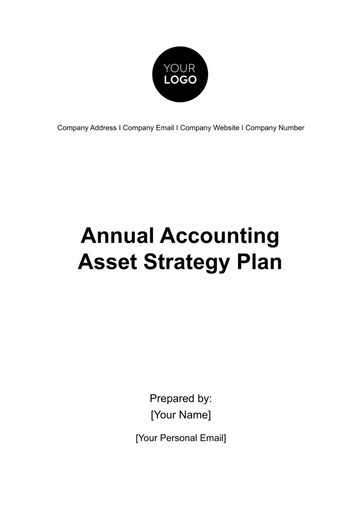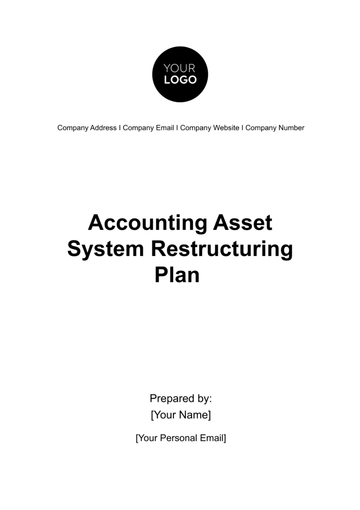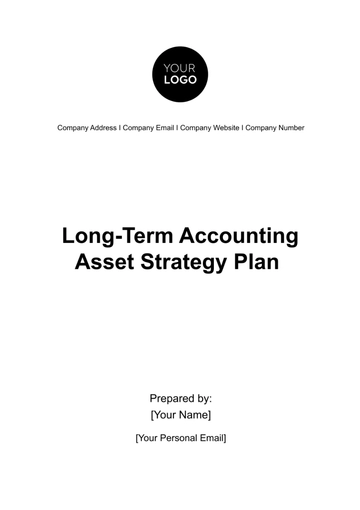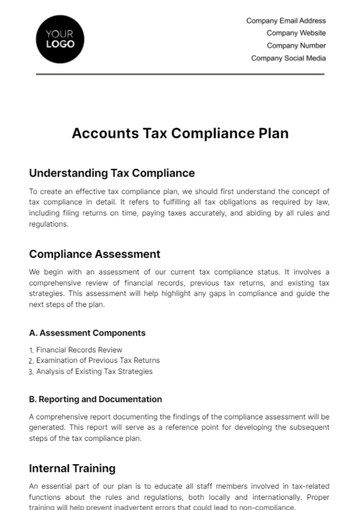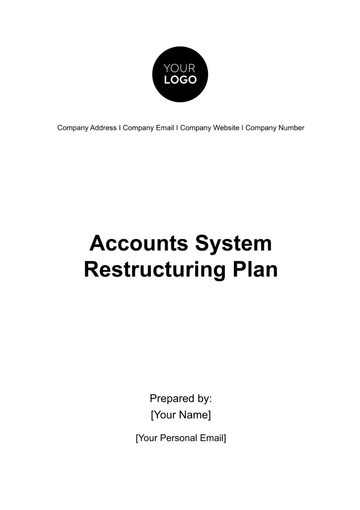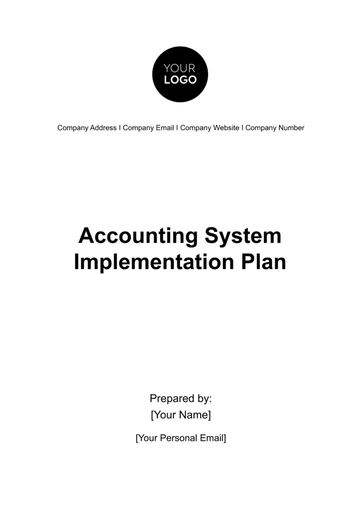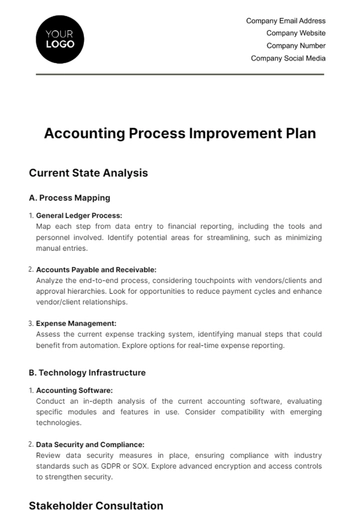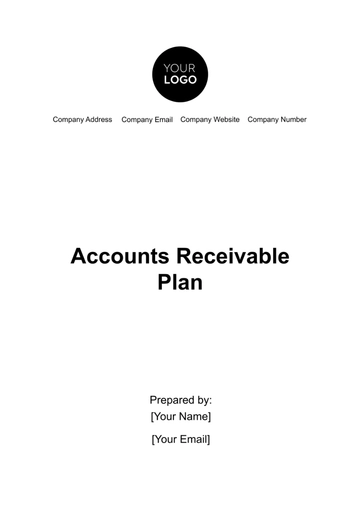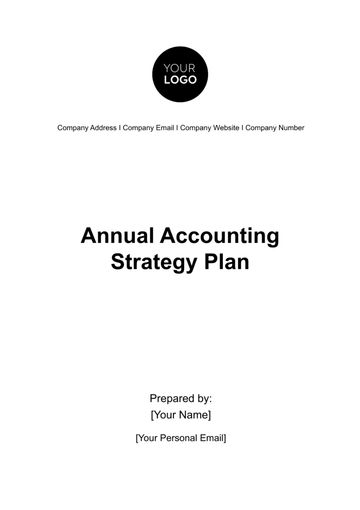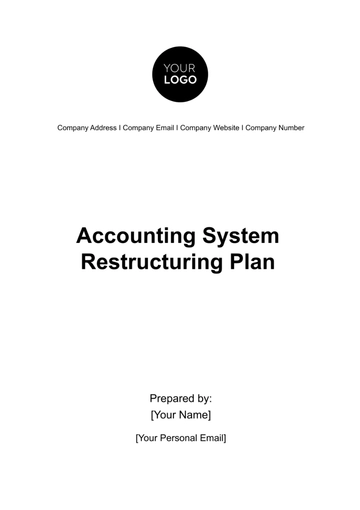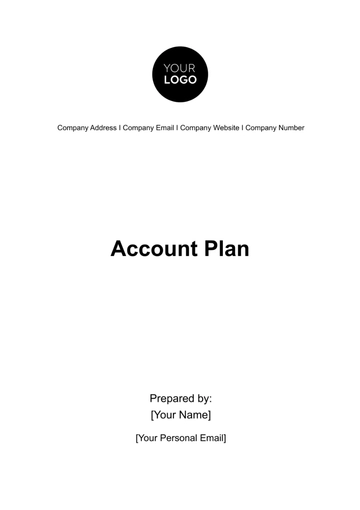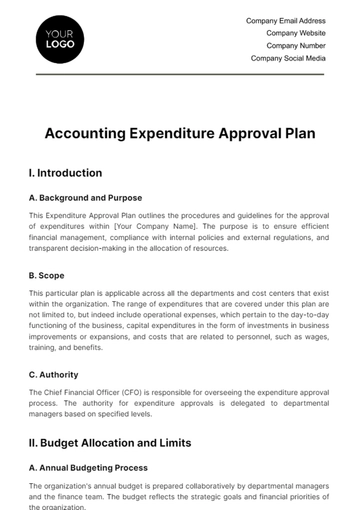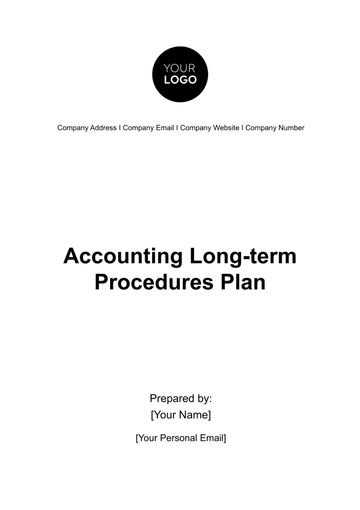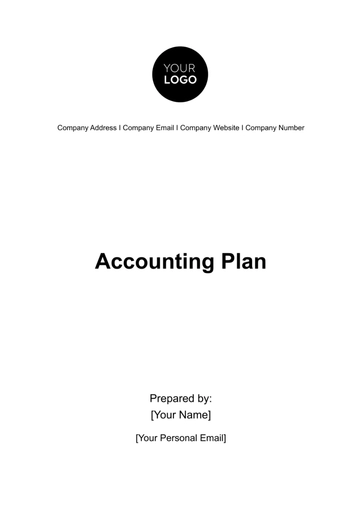Free Accounts System Restructuring Plan
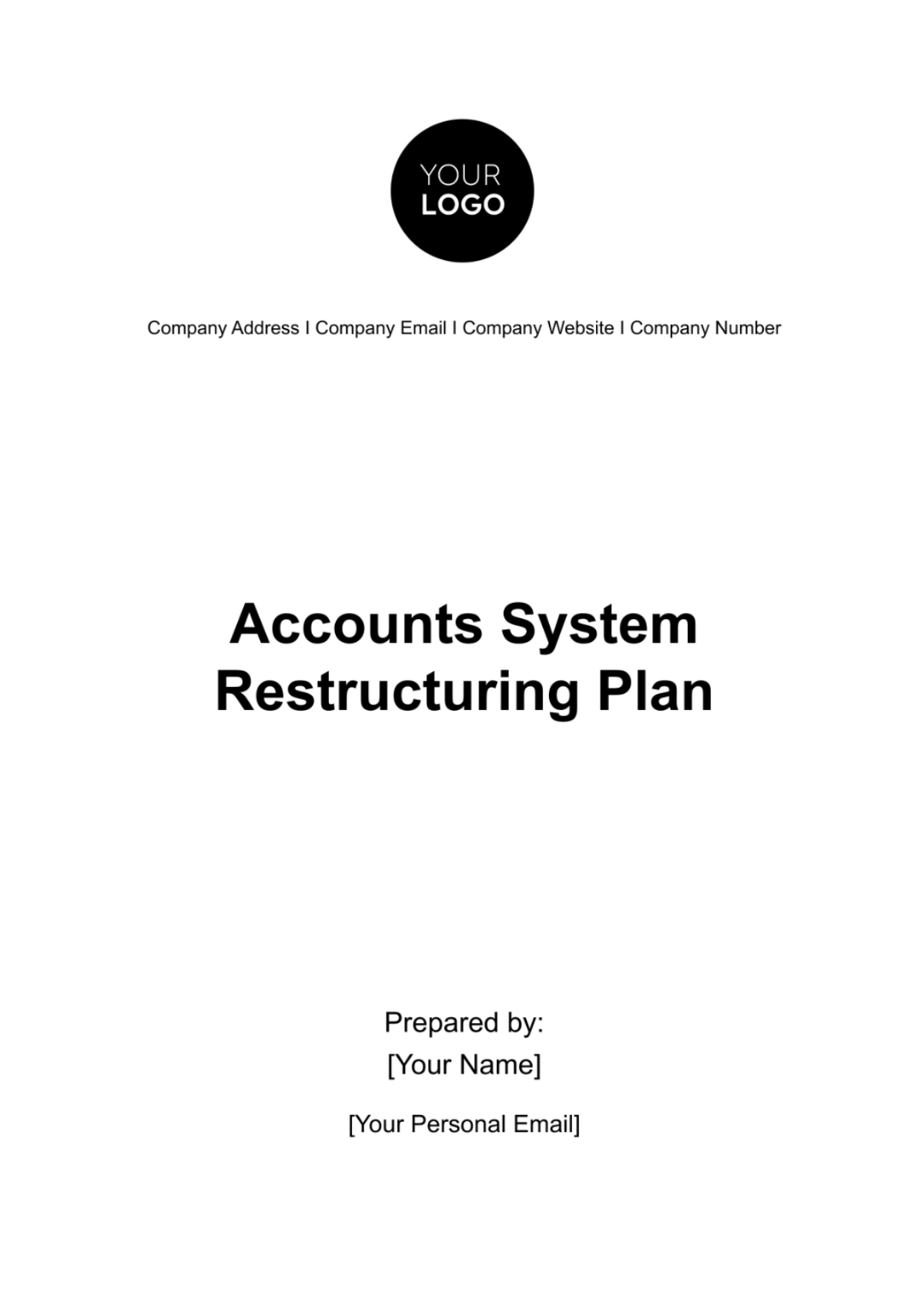
I. Executive Summary
A. Introduction
Welcome to the Accounts System Restructuring Plan for [Your Company Name]. This comprehensive plan outlines our strategy to enhance the efficiency, accuracy, and overall effectiveness of our accounting systems. In response to evolving business needs and technological advancements, this initiative aims to optimize our financial management processes and ensure compliance with industry standards.
B. Key Objectives
Efficiency Enhancement: Streamline accounting processes to reduce manual efforts by 30%.
Accuracy and Reliability: Improve accuracy in financial reporting, aiming for a 20% reduction in error rates.
Compliance Assurance: Strengthen internal controls to achieve full compliance with industry regulations.
Timely Reporting: Implement systems for real-time financial reporting to reduce reporting delays by 50%.
Integration with Business Processes: Ensure seamless integration with other business systems for efficient information flow.
Adaptability to Growth: Design systems capable of accommodating a 20% growth in organizational operations.
Enhanced Decision Support: Improve reporting capabilities for better decision-making and strategic planning.
Employee Empowerment: Implement a comprehensive training program for accounting staff, fostering a culture of continuous learning.
Cost Efficiency: Optimize resource allocation to achieve a 15% reduction in accounting-related expenses.
Customer and Stakeholder Confidence: Enhance confidence in financial management through transparent and reliable reporting.
C. Scope of Restructuring
The restructuring that is scheduled to take place is going to be extensive, covering every aspect of the organization's accounting systems. This includes not merely the processes that are currently in place, but also the technology infrastructure that supports these operations. In addition, the chart of accounts, an essential component of the accounting systems, will also be subject to this comprehensive restructuring.
II. Current State Assessment
A. Overview of Existing Systems
Our current accounting systems, comprising modules for accounts payable, accounts receivable, and general ledger, have been instrumental in managing financial transactions. However, a comprehensive review has highlighted challenges in data reconciliation and a notable dependence on manual input. Additionally, the existing reporting features lack real-time capabilities, limiting our responsiveness to dynamic business needs. This assessment underscores the necessity for a restructuring initiative to modernize and optimize our accounting systems.
B. Chart of Accounts (CoA) Review
With the current chart of accounts (CoA) encompassing a substantial number of accounts, there's a recognition of the need for simplification and alignment with our evolving organizational structure. Proposed changes include consolidating redundant accounts, introducing subcategories for enhanced granularity, and revising nomenclature for better clarity. This CoA restructuring aims not only to improve internal reporting but also to facilitate a more intuitive understanding of financial data for stakeholders across various departments.
C. Technology Infrastructure
Our technology infrastructure, anchored by [Current Accounting Software], has been effective but is now poised for a transformation. An evaluation of the current software versions has identified opportunities for enhancement, necessitating potential upgrades to leverage the latest features and security measures. In parallel, we are exploring the adoption of [New Accounting Software] to address emerging business needs, enhance scalability, and ensure seamless integration with other vital business systems.
III. Objectives and Goals
A. Efficiency Improvement
To realize efficiency improvement, our strategy involves introducing automated workflows for routine processes such as invoice processing and expense approvals. This automation aims to significantly reduce manual intervention, minimize errors, and expedite transaction processing. Additionally, we will implement advanced reconciliation tools that can proactively identify discrepancies, ensuring swift resolution and promoting a more streamlined reconciliation process.
B. Accuracy and Reliability
Ensuring the accuracy and reliability of our financial data is paramount. To achieve this, we plan to conduct regular internal audits, employing data analytics tools to identify and rectify errors promptly. Furthermore, we will enhance the integrity of our financial data by implementing validation checks within the accounting software, reducing the likelihood of inaccuracies during data entry and processing.
C. Compliance Assurance
Our commitment to compliance assurance involves strengthening internal controls through a systematic review of segregation of duties. By implementing stricter access controls and regular audits, we aim to meet and exceed regulatory requirements. Additionally, we will establish a robust system for tracking changes in accounting standards, ensuring timely updates to our practices and policies to stay in compliance with evolving regulations.
D. Timely Reporting
To achieve timely reporting, we will implement real-time reporting dashboards that provide instant visibility into key financial metrics. This initiative aims to reduce reporting cycle times significantly, enabling timely decision-making based on up-to-date financial information. Additionally, we will establish a structured reporting schedule with clear deadlines, ensuring that all stakeholders receive relevant financial reports promptly, fostering greater transparency and accountability.
E. Integration with Business Processes
Our plan for seamless integration involves assessing integration points with other business systems, such as inventory management and customer relationship management (CRM). By identifying and optimizing these integration points, we aim to eliminate data silos and create a unified information flow across the organization. Simultaneously, we will implement middleware solutions to facilitate efficient and secure data exchange, ensuring a synchronized and cohesive business ecosystem.
IV. Strategies and Action Plans
A. Process Improvement
In our pursuit of process improvement, a detailed analysis will be conducted to identify bottlenecks and inefficiencies in the current workflow. We will introduce automation for routine tasks such as invoice processing and expense approvals, aiming to significantly reduce manual efforts and expedite transaction processing. Furthermore, the implementation of advanced reconciliation tools will enhance accuracy and expedite the reconciliation process, ensuring a streamlined financial close. To monitor the success of these initiatives, key performance indicators (KPIs) related to process efficiency and effectiveness will be established, providing quantitative metrics for ongoing evaluation and improvement.
B. Technology Upgrade or Implementation
Our technology strategy involves a meticulous evaluation of the latest versions of existing accounting software for potential upgrades. Simultaneously, we are exploring the adoption of [New Accounting Software], conducting a thorough cost-benefit analysis to ensure that the chosen solution aligns with our long-term goals. Collaboration with the IT department is paramount to ensure seamless integration with existing systems, and to address potential challenges that may arise during the implementation phase. To provide dedicated support, a specialized IT team will be established, ensuring efficient troubleshooting during and post-implementation, promoting a smooth transition to the new technology landscape.
C. Internal Controls Enhancement
To enhance internal controls, a comprehensive review of current internal control processes will be conducted. Stricter access controls and segregation of duties will be implemented to prevent unauthorized transactions and fortify the integrity of financial data. Regular audit schedules will be established to ensure ongoing compliance with internal control policies and identify areas for improvement. Recognizing the critical role of staff in maintaining effective controls, a training program will be introduced to educate them on the significance of internal controls and their role in ensuring compliance with regulatory standards.
D. Staff Training and Development
Our approach to staff training involves the development of a comprehensive curriculum that covers various modules, including software usage, reporting tools, and data analytics. Utilizing a mix of online courses, workshops, and hands-on sessions will cater to diverse learning styles, ensuring maximum engagement and knowledge retention. Encouraging staff to participate in continuous education programs and certifications will not only enhance their skills but also contribute to a culture of continuous learning within the organization. Establishing mentorship programs will facilitate knowledge transfer among experienced and new team members, fostering collaboration and creating a supportive learning environment.
E. Reporting Improvements
To enhance reporting capabilities, we will collaborate closely with department heads to identify specific reporting needs tailored to each functional area. Customized reporting templates will be developed to align with key performance indicators (KPIs) relevant to each department, ensuring that reports provide actionable insights. The implementation of real-time reporting dashboards will provide immediate access to critical financial metrics, empowering decision-makers with up-to-the-minute information. Regular feedback mechanisms will be established to iteratively improve reporting structures based on user experience, ensuring that reports remain dynamic and relevant.
F. Change Management
Our change management strategy involves designing a comprehensive communication plan that addresses the needs of stakeholders at all levels. Town hall meetings and department-specific briefings will be conducted to address concerns, provide clarity, and garner support for the restructuring initiative. Change ambassadors within each department will play a pivotal role in facilitating a smooth transition by serving as communication conduits and providing assistance to their colleagues. Utilizing feedback channels, we will assess the impact of changes and make necessary adjustments, ensuring that the organizational culture remains positive and adaptive throughout the transformation.
G. Timeline and Milestones
For effective implementation, a detailed project plan will be developed outlining phases and milestones. Timelines for each phase will be established, considering dependencies and potential challenges that may arise. Regular progress reviews will be conducted to assess progress against milestones, and adjustments will be made as needed. Celebrating key milestones will not only acknowledge the collective effort of the team but also maintain morale and momentum throughout the restructuring initiative.
H. Budget and Resource Allocation
Our budgeting strategy involves conducting a thorough analysis of costs associated with technology upgrades, training, and implementation. Resources will be allocated based on the critical needs of each phase, ensuring that the project stays within budgetary constraints. Collaboration with the finance team will be ongoing to monitor and control expenses throughout the project, with flexibility to adjust resource allocation based on evolving requirements and feedback.
I. Risk Management
Our risk management plan involves identifying potential risks through a comprehensive risk assessment. Contingency plans for critical processes will be developed to mitigate potential disruptions, with a dedicated risk management team established to monitor and address emerging risks in real-time. Regular risk reviews will be conducted, and strategies will be adjusted proactively to address changing circumstances. A culture of risk awareness and responsiveness will be cultivated to ensure the success and resilience of the restructuring initiative.
V. Implementation
A. Phased Approach
The implementation will follow a phased approach, each carefully planned to ensure a smooth transition and minimize disruptions. Phase 1 will focus on Technology Assessment and Selection, evaluating existing systems and determining the best approach for upgrades or replacements. In Phase 2, Staff Training and Development will take center stage, ensuring that team members are well-prepared for the upcoming changes. Phase 3 will involve Software Implementation and Integration, with a meticulous focus on ensuring seamless compatibility with existing systems. Phase 4 will encompass Process Improvement Initiatives, introducing automation and refining workflows. Finally, Phase 5 will concentrate on Reporting Enhancements, providing stakeholders with improved insights and information.
B. Monitoring and Evaluation
To monitor implementation progress, a dedicated implementation team will be established to track key performance indicators. Regular reviews will be conducted to assess progress against milestones, and feedback mechanisms will be utilized to identify and address any challenges that arise. Celebrating achievements will play a vital role in maintaining morale and motivation throughout the implementation phase. Transparent communication channels will be maintained to ensure that team members are well-informed about progress and upcoming milestones. Continuous monitoring and iterative adjustments will be the hallmarks of our approach to implementation.
VI. Post-Implementation
A. Feedback and Adjustments
Post-implementation, feedback will be solicited from end-users through surveys and focus group discussions. A dedicated analysis of this feedback will be conducted to identify areas for improvement, and necessary adjustments to processes, systems, and training programs will be made promptly. Transparent communication about these adjustments will be maintained to keep stakeholders informed and engaged. The iterative nature of post-implementation adjustments will ensure that the organization remains agile and responsive to evolving needs.
B. Ongoing Improvement
Our commitment to ongoing improvement includes the establishment of a continuous improvement team tasked with monitoring system performance. Regular reviews of key performance indicators will be conducted, and strategies will be adjusted accordingly. A culture of innovation and feedback will be actively encouraged within the accounting and finance departments, ensuring that team members feel empowered to contribute ideas for further improvement. Proactive exploration of emerging technologies and industry best practices will be prioritized to keep our financial management capabilities at the forefront of innovation.
VII. Conclusion
A. Summary of Achievements
Upon completion of the restructuring plan, we anticipate significant achievements. Streamlined workflows and reduced manual efforts will result in a more efficient financial operation. Enhanced accuracy and reliability in financial reporting will boost stakeholder confidence. Full compliance with regulatory requirements will reinforce our governance framework. Timely reporting capabilities will enable quicker decision-making, and seamless integration with other business systems will foster a cohesive organizational ecosystem. Adaptability to growth, empowered employees, improved cost efficiency, and elevated customer and stakeholder confidence will mark the success of the restructuring initiative.
B. Future Roadmap
Looking ahead, our future roadmap includes continuous monitoring and adjustment of systems and processes, ongoing investment in employee development and training programs, exploration of emerging technologies to further enhance financial management capabilities, collaboration with industry experts to stay abreast of evolving best practices, and strategic partnerships and collaborations to support future growth initiatives. Our commitment to transparency, integrity, and excellence in financial management will remain unwavering as we continue on our journey of continuous improvement and innovation.
- 100% Customizable, free editor
- Access 1 Million+ Templates, photo’s & graphics
- Download or share as a template
- Click and replace photos, graphics, text, backgrounds
- Resize, crop, AI write & more
- Access advanced editor
Elevate your financial strategy with the Accounts System Restructuring Plan Template from Template.net. This editable and customizable template, powered by an intuitive AI Editor Tool, streamlines your restructuring process. Achieve efficiency, compliance, and growth seamlessly. Transform your financial landscape effortlessly with a template designed for success. Embrace innovation with ease – your path to financial excellence starts here.
You may also like
- Finance Plan
- Construction Plan
- Sales Plan
- Development Plan
- Career Plan
- Budget Plan
- HR Plan
- Education Plan
- Transition Plan
- Work Plan
- Training Plan
- Communication Plan
- Operation Plan
- Health And Safety Plan
- Strategy Plan
- Professional Development Plan
- Advertising Plan
- Risk Management Plan
- Restaurant Plan
- School Plan
- Nursing Home Patient Care Plan
- Nursing Care Plan
- Plan Event
- Startup Plan
- Social Media Plan
- Staffing Plan
- Annual Plan
- Content Plan
- Payment Plan
- Implementation Plan
- Hotel Plan
- Workout Plan
- Accounting Plan
- Campaign Plan
- Essay Plan
- 30 60 90 Day Plan
- Research Plan
- Recruitment Plan
- 90 Day Plan
- Quarterly Plan
- Emergency Plan
- 5 Year Plan
- Gym Plan
- Personal Plan
- IT and Software Plan
- Treatment Plan
- Real Estate Plan
- Law Firm Plan
- Healthcare Plan
- Improvement Plan
- Media Plan
- 5 Year Business Plan
- Learning Plan
- Marketing Campaign Plan
- Travel Agency Plan
- Cleaning Services Plan
- Interior Design Plan
- Performance Plan
- PR Plan
- Birth Plan
- Life Plan
- SEO Plan
- Disaster Recovery Plan
- Continuity Plan
- Launch Plan
- Legal Plan
- Behavior Plan
- Performance Improvement Plan
- Salon Plan
- Security Plan
- Security Management Plan
- Employee Development Plan
- Quality Plan
- Service Improvement Plan
- Growth Plan
- Incident Response Plan
- Basketball Plan
- Emergency Action Plan
- Product Launch Plan
- Spa Plan
- Employee Training Plan
- Data Analysis Plan
- Employee Action Plan
- Territory Plan
- Audit Plan
- Classroom Plan
- Activity Plan
- Parenting Plan
- Care Plan
- Project Execution Plan
- Exercise Plan
- Internship Plan
- Software Development Plan
- Continuous Improvement Plan
- Leave Plan
- 90 Day Sales Plan
- Advertising Agency Plan
- Employee Transition Plan
- Smart Action Plan
- Workplace Safety Plan
- Behavior Change Plan
- Contingency Plan
- Continuity of Operations Plan
- Health Plan
- Quality Control Plan
- Self Plan
- Sports Development Plan
- Change Management Plan
- Ecommerce Plan
- Personal Financial Plan
- Process Improvement Plan
- 30-60-90 Day Sales Plan
- Crisis Management Plan
- Engagement Plan
- Execution Plan
- Pandemic Plan
- Quality Assurance Plan
- Service Continuity Plan
- Agile Project Plan
- Fundraising Plan
- Job Transition Plan
- Asset Maintenance Plan
- Maintenance Plan
- Software Test Plan
- Staff Training and Development Plan
- 3 Year Plan
- Brand Activation Plan
- Release Plan
- Resource Plan
- Risk Mitigation Plan
- Teacher Plan
- 30 60 90 Day Plan for New Manager
- Food Safety Plan
- Food Truck Plan
- Hiring Plan
- Quality Management Plan
- Wellness Plan
- Behavior Intervention Plan
- Bonus Plan
- Investment Plan
- Maternity Leave Plan
- Pandemic Response Plan
- Succession Planning
- Coaching Plan
- Configuration Management Plan
- Remote Work Plan
- Self Care Plan
- Teaching Plan
- 100-Day Plan
- HACCP Plan
- Student Plan
- Sustainability Plan
- 30 60 90 Day Plan for Interview
- Access Plan
- Site Specific Safety Plan


